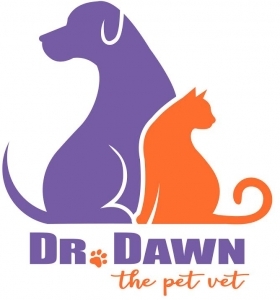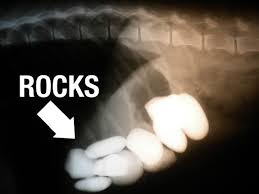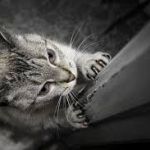There are many things that dogs do that often seem to make no sense. Eating their own poop, or other strange objects are two of them. But, it turns out that there may be good reasons that they do these gross things. I get asked about it often, so thought it worth blogging about.
Pica is the eating of non-food substances such as rocks, soil, and clothing. Coprophagy is the consumption of feces, and it is much more common in dogs than cats. Cats tend to eat more curious items such as clothing, strings and kitty litter. Rarely, underlying diseases are the cause, but we veterinarians are still not sure why the majority of dogs do it.
PICA
When eaten, some objects may cause blockages of the digestive tract, requiring surgery to remove them. Sometimes we can remove them with an endoscope. Owners can prevent pets from eating objects by eliminating access to the objects, making the objects unpleasant to taste, enriching the pet’s environment to prevent boredom, or using muzzles on walks. Also, you might choose to enlist the help of a veterinary behaviorist or a trainer to help eliminate the unwanted behavior.
COPROPHAGY
The consumption of feces is a natural behavior for nursing mothers to eat the feces of their puppies or kittens. Coprophagy is more common in female dogs than male dogs. Even though it is generally more distasteful than it is harmful to the pet, eating non-food objects may result in vomiting, diarrhea.
BUT, WHY?
While the exact cause of both pica and coprophagy is unknown, some pets chew on objects out of stress or boredom. Dogs may eat feces because they are not being fed enough or if they go too long between meals. But, it is usually because they are lacking a nutrient in the diet.
Dogs who have previously been punished for defecating in the house may eat their feces to avoid further punishment. Others who are (or have been) confined for long periods of time may become accustomed to eating their feces by way of keeping their bedding from wing soiled.
Rarely an underlying condition such as anemia, intestinal parasites, gastrointestinal disorders, or liver disease may lead to an animal eating strange things. Administration of some drugs, such as steroids, can increase hunger and lead to pica as well.
SYMPTOMS AND DIAGNOSIS
Usually, owners either see the pet eating things they shouldn’t, or find remnants of the objects around the house. Cats are especially inclined to eat linear objects, such as strings dental floss, rubber bands and yarn.Signs your pet may have ingested an object that may cause a blockage in the digestive tract include:
– vomiting
– diarrhea or constipation
– loss of appetite
– lethargy (tiredness, lack of normal level of activity)
If you suspect that your pet may have these problems, contact your veterinarian. Though most cases of pica and coprophagy are simply behavior problems, it is important for veterinarians to rule out a medical cause first. They would perform an exam and ask specific questions about your pet’s diet, appetite, and environment. Additional tests may include blood work, fecal tests looking for parasites or possibly malabsorption or maldigestion conditions, or possibly an intestinal biopsy. Usually, treating the underlying disease, if present, will help eliminate the behavior. Sometimes the solution is a different diet, or having someone let out your dog while you are out for long periods.
Dr. Dawn
Please share and subscribe here








